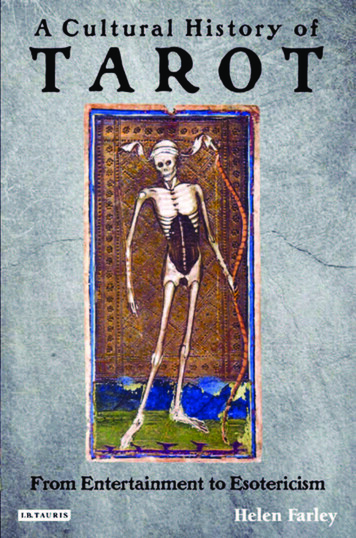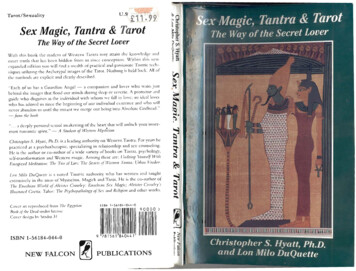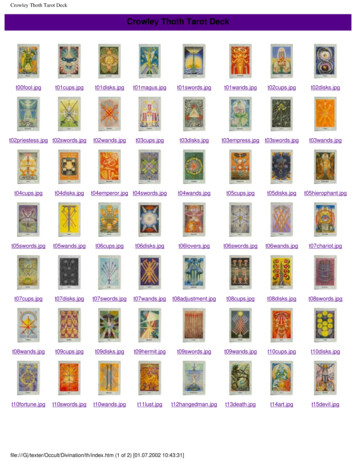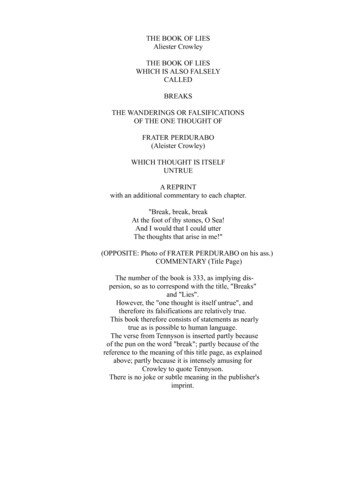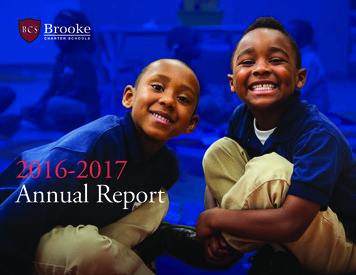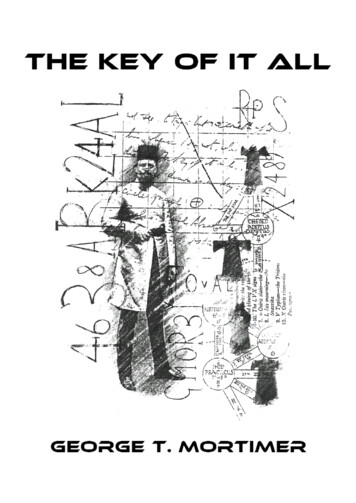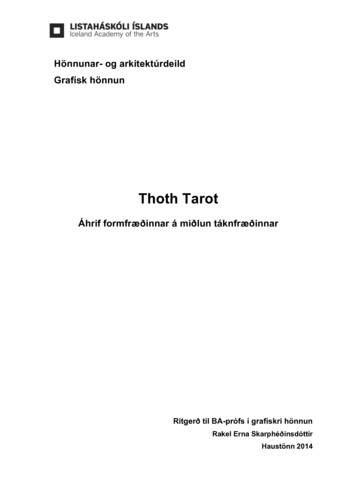
Transcription
Brooke Erin CrowleyDepartments of Geology and AnthropologyUniversity of Cincinnati, Cincinnati, OH 45221Phone: 513-556-7181 Fax: 513-556-6931Email: brooke.crowley@uc.edu Website: www.agoraphotia.comPROFESSIONAL APPOINTMENTS2021-present Professor, Department of Geosciences, University of Cincinnati2021-present Professor, Department of Anthropology, University of Cincinnati2018-present Graduate Director, Department of Geosciences, University of Cincinnati2017-2021Associate Professor, Department of Geology, University of Cincinnati2017-2021Associate Professor, Department of Anthropology, University of Cincinnati2011-2017Assistant Professor, Department of Geology, University of Cincinnati2011-2017Assistant Professor, Department of Anthropology, University of Cincinnati2012-present Affiliate Faculty, Department of Environmental Studies, University of Cincinnati2011-present Research Associate, Vertebrate Paleontology, Cincinnati Museum Center2010-2011Lecturer, Department of Anthropology, University of Toronto2009-2010Postdoctoral Fellow, Department of Anthropology, University of TorontoEDUCATION2008-2009Doctor of Philosophy, Ecology and Evolutionary Biology, University of California, Santa CruzThesis: The stable isotope ecology of Madagascar’s lemursAdvisors: Drs. Paul Koch and Nathaniel Dominy2005-2008Master of Arts, Biological Anthropology, Anthropology, University of California, Santa CruzAdvisors: Drs. Paul Koch and Nathaniel Dominy2003-2005Master of Science, Earth Sciences, University of California, Santa CruzThesis: Tracing the isotopic rainshadow and elevation history of the Sierra NevadaMountains, CaliforniaAdvisor: Dr. Paul Koch1998-2002Bachelor of Arts, Geology, Cum Laude, Vassar CollegeHonors Thesis: Microbe association with the Wappingers GroupAdvisor: Friedrich Pflüger1998High School Diploma, Cranbrook Schools, Bloomfield Hills, MIRESEARCHResearch InterestsMy primary research interests include conservation ecology and paleoecology, food webs, niche partitioning,community ecology, mobility, human-animal interactions, ecological repercussions of habitat fragmentation anddegradation, and understanding the causes and consequences of extinction events.Brooke E. Crowley Curriculum Vitae, Updated July 20221
Awards and Honors2008Best Student Oral Presentation (2nd place), International Primatological Society Congress XXII2005 & 2006 Outstanding Teaching Assistant, Earth Sciences Department, University of California, Santa Cruz2004Outstanding Student Employee, University of California, Santa Cruz2002Outstanding Student, Erminnie Adele Platt Smith Excellence in Mineralogy and Geology, Vassar1999-2002Outstanding Student Employee, Vassar CollegeFundingExternal Proposals Funded:2021-2024UC PI National Science Foundation EAR-2047818 185,556 (UC)“Collaborative Research: Integrative ecological perspectives on extinction processes a multi-proxy case study of Hispaniolan subfossil and extant rodents” (Lead PI: SiobhánCooke, Johns Hopkins)2021-2022Co-PI2018-2023UC PI National Science Foundation Award BCS-1749676 81,125 (UC)“Collaborative research: Human and non-human influences on species biodiversity in anisland ecosystem” (Lead PI: Laurie Godfrey, UMASS Amherst)2019PINorth American Falconers Association 2nd Year Renewal 1,850“Can strontium and hydrogen isotopes identify breeding grounds? Testing a dual-isotopeapproach for refining natal areas for migratory accipiters in North America”2017PINorth American Falconers Association 1,000“Can strontium and hydrogen isotopes identify breeding grounds? Testing a dual-isotopeapproach for refining natal areas for migratory accipiters in North America”2017PISophie Danforth Conservation Biology Fund 2nd Year Renewal“Can isotopes in feces track the mobility of difficult to observe mammals?” 1,0002016PISophie Danforth Conservation Biology Fund“Can isotopes in feces track the mobility of difficult to observe mammals?” 1,0002012-2016Co-PINational Science Foundation EAR-1229114 400,000“MRI: Acquisition of Stable Isotope Instrumentation for BiogeochemistryResearch and Teaching at the University of Cincinnati” (PI: Aaron Diefendorf)2012-2015Co-PIOhio Board of Regents Action Fund 1010052In support of NSF EAR-12291142013PIRalph E. Powe Junior Faculty Enhancement Award, ORAU 5,0002008Co-PIUniversity of California Lab Fees Grant“Climate change, lemurs and recent megafaunal extinction” 128,900National Science Foundation Award EAR-2110297 108,503“Acquisition of a high temperature elemental analyzer for hydrogen and oxygen isotopeanalysis of waters and solids for the University of Cincinnati Stable Isotope Laboratory”.(PI: Aaron Diefendorf, UC)Brooke E. Crowley Curriculum Vitae, Updated July 2022 85,7142
2006PIPhi Beta Kappa Scholarship 5,000External Proposals Pending:2022-2025 Co-PIDGE-NSF Research Traineeship 499,999“IGE: Engaging Science: Transforming Graduate Education through Public Engagementwith Science” (Lead-PI Angela Potochnik)Internal Funding:2020PITaft Research Center“Presenting at the Virtual AAPA 2020” 4402019Co-PICollege Structures Initiative“Developing curricular offerings for science outreach” 5,0002019PITaft Research Center“Presenting at the AAPA 2019” 1,2002018PIUC Individual Faculty Development Grant“Presenting and mentoring at the 2018 GSA Conference” 8822018PITaft Research Center“Travel to international biennial conference held in Chile” 2,7002017PIUC Individual Faculty Development Grant“Presenting and networking at the 2017 AAPA Conference” 1,2622016PITaft Research Center 1,200“Presenting and networking at the International Primatological Society/American Societyof Primatologists joint meeting, August 20-27 2016, Chicago”2016Co-PIUC Academy of Fellows for Teaching and Learning“UC Energy & Education Initiative – ‘WATT is a BTU?’” 6,7592016Co-PISTEM Interdisciplinary Grant“UC Energy & Education Initiative – ‘WATT is a BTU?”’ 5,7302013-2014Co-PIUC Forward teaching initiative renewal 10,000“Changing landscapes, dynamic environments, and geohazards in the Himalaya”2013-2014Co-PIUC Forward teaching initiative renewal“Surviving Climate Change” 5,7002013PIUC Individual Faculty Development GrantConference, Collaboration and Research in Gainesville, Florida 1,8412013PIUniversity of Cincinnati Research Council 6,500“Assessing vehicle related pollution along the Manali-Leh Highway, Indian Himalaya”2013PIUC Individual Faculty Development Grant“Isotope Ratio Mass Spectrometer Training Course”2012-2013PIUniversity of Cincinnati Research Council 24,700“Extinction and Education: Documenting Late Pleistocene Chronostratigraphy andPaleoenvironment of Big Bone Lick, State Park”Brooke E. Crowley Curriculum Vitae, Updated July 2022 3,1743
2012-2013Co-PI UC Forward teaching initiative 10,000“Changing landscapes, dynamic environments, and geohazards in the Himalaya”2012-2013Co-PI UC Forward teaching initiative“Surviving Climate Change” 5,7002011University of Toronto CUPE Conference Fund 6002009Vassar College Graduate Fellowship 2,0002008Vassar College Graduate Fellowship 5,0002008Teaching Assistant Sabbatical 8,9232008Center on the Dynamics and Evolution of the Land-Sea Interface travel grant 5002008Center on the Dynamics and Evolution of the Land-Sea Interface mini grant 9002008UC Santa Cruz Institute for Geophysics and Planetary Physics mini grant 9002006Center for Tropical Research in Ecology, Agriculture, and Development grant 1,2002007Vassar College Graduate Fellowship 3,0002003-2005Center for Informal Learning and Schools (CILS) Fellowship2003Gerald Weber and Suzanne Holt Field Camp Scholarship 15,000 annually 250PublicationsPeer Reviewed Papers:#Indicates Undergraduate Student and †Indicates Graduate Student. Up to date citations for each entry can befound on Google Scholar. pdfs of all publications are available at brookecrowleypublications.wordpress.com).ORCiD: 0000-0002-8462-6806.In ReviewCrowley, B.E., Schmidt, H.S., and Vorontsova, M.S. Carbon isotope values for grasses inMadagascar’s Central Highlands establish baselines for historical and palaeoecologicalresearch. Submitted to People, Plants, Planet.In ReviewCrowley, B.E.*, Wultsch, C.*, Simpson, E.M.B.†, Kelly, M.J. Applying molecular scatology andfecal isotopes to non-invasively study spatial ecology of elusive carnivorans: a case study withwild jaguars (Panthera onca). Submitted to European Journal of Wildlife Research.*Authors contributed equallyIn ReviewReid, R.B., Crowley, B.E., and Haupt, R. The prospects of poop: A review of past achievementsand future possibilities of fecal isotope analysis. Submitted to Biological Reviews.2022Britton, K., Crowley, B.E., Bataille, C.P., Miller, J.H., and Wooller, M. Editorial: A golden age forstrontium isotope research? Current advances in paleoecological and archaeological research.Frontiers in Ecology and Evolution 9: 820295.2022Cooke, S.B., and Crowley, B.E. New radiocarbon dates reveal pan-Holocene deposition ofrodents at Trouing Jérémie #5, a sinkhole in the western Tiburon Peninsula, Haiti. The Holocene32: 991-997.Brooke E. Crowley Curriculum Vitae, Updated July 20224
2022Miller, J.H., Fisher, D.C., Crowley, B.E., Secord, R., and Bledar, A.K. Male mastodon landscapeuse changed with maturation (Late Pleistocene, North America). Proceedings of the NationalAcademy of Sciences 119(25): 32118329119.2021Britton, K., Crowley, B.E., Bataille, C.P., Miller, J.H., and Wooller, M.J. Perspective: SilverLinings at the Dawn of a ‘Golden Age’. Frontiers in Ecology and Evolution 9: 748938.2021Crowley, B.E.*, Bataille, C.P.*, Haak, B., Sommer, K.M.# Identifying nesting grounds formigratory birds with dual isotope provenancing: A test with North American raptors. Ecosphere12(10): e03765.*Authors contributed equally2021Crowley, B.E., Godfrey, L.R., Hansford, J.P., and Samonds, K.E. Seeing the forest for the trees– and the grasses: Revisiting the evidence for grazer-maintained grasslands in Madagascar’sCentral Highlands. Proceedings of the Royal Society of London B 288: 20201785.2021Faina, P.†, Burns, S.J., Godfrey, L.R., Crowley, B.E., Scroxton, N., McGee, D., Sutherland,M.R., and Ranivoharimanana, L. Comparing the paleoclimates of northwestern andsouthwestern Madagascar during the late Holocene: implications for the role of climate inmegafaunal extinction. Malagasy Nature 15: 108-127.2021Godfrey, L.R., Crowley, B.E., Muldoon, K.M., Burns, S.J., Scroxton, H., Klukkert, Z.S.,Ranivoharimanana, L., Alumbaugh, J., Borths, M., Dart, R., Faina, P., Goodman, S.M., Guierrez,I.J., Hansford, J.P., Hekkala, E.R., Kinsley, C.W., Lehman, P., Lewis, M.E., McGee, D., Pérez,V.R., Rahantaharivao, N.J., Rakotoarijaona, M., Rasolonjatovo, A.M., Samonds, K.E., Turvey,S.T., Vasey, N., and Widmann, P. Teasing apart impacts of human activity and regional droughton Madagascar’s megafauna: insights from new excavations at Tsimanampesotse andAntsirafaly. Frontiers in Ecology and Evolution 9: 742203.2021Hixon, S.W.,† Douglass, K.G., Godfrey, L.R., Eccles, L., Crowley, B.E., Rakotozafy, L.M.A.,Clark, G., Haberle, S., Anderson, A., Wright, H.T., Kennett, D. Ecological consequences of amillennium of introduced dogs on Madagascar. Frontiers in Ecology and Evolution 9: 689559.2021Hixon, S.W.,† Douglass, K.G., Crowley, B.E., Rakotozafy, L.M.A., Clark, G., Anderson, A.,Haberle, S., Ranaivoarisoa, J.F., Buckley, M., Fidiarisoa, S., Mbola, B., Kennett, D.J. LateHolocene spread of pastoralism coincides with endemic megafaunal extinction on Madagascar.Proceedings of the Royal Society B 288:20211204.2021Lentz, D.L., Slotten, V., Dunning, N.P., Jones, J.G., Scarborough, V.L., McCool, J-P., Owen,L.A., Fladd, S.G., Tankersley, K.B., Perfetta, C.J., Carr, C., Crowley, B.E., and Plog,S. Ecosystem impacts by the ancestral Puebloans of Chaco Canyon, New Mexico, USA. PLoSONE 16(10): e0258369.2021Marciniak, S., Mughal, M.R., Godfrey, L.R., Bankoff, R.J., Randrianatoandro, H., Crowley, B.E.,Bergey, C.M, Muldoon, K.M., Randrianasy, J., Raharivololona, B.M., Miller, W., Schuster, S.C.,Malhi, R.S., Yoder, A.D., Louis Jr., E.E., Kistler, L., and Perry, G. Evolutionary and phylogeneticinsights from a nuclear genome sequence of the extinct, giant ‘subfossil’ koala lemurMegaladapis edwardsi. Proceedings of the National Academy of Sciences 118: e20221171182021Miller, J.H., Crowley, B.E., Bataille, C.P., Wald, E.J., Kelly, A.†, Gaetano, M.†, Bahn, V., andDruckenmiller, P. Historical landscape use of migratory caribou: New insights from old antlers.Frontiers in Ecology and Evolution 8: 590837Brooke E. Crowley Curriculum Vitae, Updated July 20225
2020Bataille, C.P., Crowley, B.E., Wooller, M.J., and Bowen, G.J. Advances in global bioavailablestrontium isoscapes. Palaeogeography Palaeoclimatology Palaeoecology 555: 1098492020Burney, D.A., Andriamialison, H., Andrianaivoarivelo, R., Bourne, S., Crowley, B.E., de Boer, E.,Godfrey, L.R., Goodman, S.M., Griffiths, C, Griffiths, O., Hume, J.P., Joyce, W.G., Jungers, W.L.,Marciniak, S., Middleton, G.J., Muldoon, K.M., Noromalala, E., Perez, V.R., Perry, G.H.,Randalana, R., and Wright, H.T. Subfossil lemur discoveries from the Beanka protected area inwestern Madagascar. Quaternary Research 93: 187-2032020Crowley, B.E. Captive dwarf lemurs and mouse lemurs have variable fur growth. Animals 10:1288 doi:10.3390/ani100812882020Mosher, S.G.†, Crowley, B.E., Yanes, Y., Diefendorf, A.F., and Barone, R. Spatial variability infoliar carbon and nitrogen isotope values on Tenerife reflects both climate and soils: Establishingan isotopic framework for future work. Acta Oecologica 109: 1036472019Crowley, B.E., and Godfrey, L.R. Strontium isotopes support small home ranges for extinctlemurs. Frontiers in Ecology and Evolution. 7: 490 doi: 10.3389/fevo.2019.004902019Crowley, B.E., Wultsch, C., and Kelly, M.J. Assessing the viability of isotopes in faecal matter fornon-invasively tracking jaguar landscape use. Isotopes in Environmental & Health Studies 55(5):478-498.2019Crowley, B.E., Yanes, Y., Mosher, S.G.†, and Rando, J.C. Revisiting the foraging ecology andextinction history of two endemic vertebrates from Tenerife, Canary Islands. Quaternary 2, 10;doi:10.3390/quat2010010.2019Douglass, K., Hixon, S.†, Wright, H., Wright, H.T., Godfrey, L., Crowley, B., Manjakahery, B.,Rasolondrainy, T., Crossland, Z., and Radimilahy, C. A critical review of radiocarbon datesclarifies the human settlement of Madagascar. Quaternary Science Reviews 221: 105878.2019Godfrey, L.R., Scroxton, N., Crowley, B.E., Burns, S.J., Sutherland, M.R., Pérez, V.R., Faina,P., McGee. D., and Ranivoharimanana, L. A new interpretation of Madagascar’s megafaunaldecline: the “Subsistence Shift Hypothesis”. Journal of Human Evolution 130: 126-140.2019Samonds, K.E., Crowley, B.E., Rasolofomanana, T.R.N., Andriambelomanana, M.C.,Andrianavalona, H.T., Ramihangihajason, T.N., Rakotozandry, R., Nomenjanahary, Z.B., Irwin,M.T., Wells, N.A., and Godfrey, L.R. A new late Pleistocene subfossil site (Tsaramody,Sambaina basin, central Madagascar) with implications for the chronology of habitat andmegafaunal community change on Madagascar’s central plateau. Journal of Quaternary Science34: 379-392.2019Sparks, J.A.†, Crowley, B.E., Rutherford, M.G., and Jaggernauth, D. Coastal proximity,orientation, and precipitation amount drive spatial variability in δ34S values on the Caribbeanisland of Trinidad. Journal of Applied Chemistry 108: 104372.2019Wallace, J.P.†, Crowley, B.E., and Miller, J.H. Investigating equid mobility in Miocene Florida,USA using strontium isotope ratios. Palaeogeography, Palaeoclimatology, Palaeoecology 516:232-243.2018Cooke, S.B.*, and Crowley, B.E.* Deciphering the isotopic niches of now-extinct Hispaniolanrodents. Journal of Vertebrate Paleontology 38(5): e1510414*Authors contributed equallyBrooke E. Crowley Curriculum Vitae, Updated July 20226
2018Craine, J., Elmore, A.J., Want, L. Aranibar, J., Bauters, M., Pascal Boeckx, P., Crowley, B.E.,Dawes, M.A., Delzon, S., Fajardo, A., Fang, Y., Fujiyoshi, L., Gray, A., Guerrieri, R., Gundale,M.J., Hawke, D.J., Hietz, P., Jonard, M., Kearsley, E., Kenzo, T., Makarov, M., MarañónJiménez, S., McGlynn, T.P., McNeil, B.E., Mosher, S.G., Nelson, D.M., Peri, P.L., Roggy, J.C.,Sanders-DeMott, R., Song, M., Szpak, P., Templer, P.H., Van der Colff, D., Wang, L., Werner,C., Xu, X., Yang, Y., Yu, G., Zmudczyńska-Skarbek, K. Isotopic evidence for oligotrophication ofterrestrial ecosystems. Nature Ecology and Evolution 2: 1735-1744.2018Crowley, B.E., Castro, I.#, Goodman, S.M., and Soarimalala, V. Isotopic evidence for nichepartitioning and the influence of anthropogenic disturbance on endemic and introduced rodentsin central Madagascar. The Science of Nature 105(44) https://doi.org/10.1007/s00114-0181564-y2018Hixon, S.W.†, Elliott Smith, E.A., Crowley, B.E., Perry, G.H., Kennett, D.J., and Newsome, S.D.Nitrogen isotope (δ15N) patterns for amino acids in lemur bones are inconsistent with ariditydriving megafaunal extinction in south-western Madagascar. Journal of Quaternary Science33(8): 958-968.2018McCool, J-P.P.†, Fladd, S.G., Scarborough, V.L., Plog, S., Dunning, N.P., Owen, L.A., Watson,A.S., Bishop, K.J., Crowley, B.E., Haussner, E.A.†, Tankersley, K.B., Lentz, D., Carr, C., andThress, J.L. Soil analysis in discussions of agricultural feasibility for ancient civilizations: A criticalreview and reanalysis of the data and debate from Chaco Canyon, New Mexico. PLoS ONE13(6): p.e0198290.2018Scarborough, V.L., Fladd, S.G., Dunning, N.P., Plog, S., Owen, L.A., Carr, C.,Tankersley, K.B., McCool, J-P.†, Watson, A.S., Haussner, E.A.†, Crowley, B.E., Bishop,K.J., Lentz, D.L., and Vivian, G. Water uncertainty and ritual predictability at Chaco Canyon, NewMexico. Antiquity 92(364): 870-8892018Sparks, J.A.†, and Crowley, B.E. Where did people forage in prehistoric Trinidad? Testing theutility of a multi-isotope approach for tracking the origins of terrestrial prey. Journal ofArchaeological of Science Reports 19: 968-978.2018Vrazo, M.B.†, Diefendorf, A.F., Crowley, B.E., and Czaja, A.D. Late Cretaceous marinearthropods relied on terrestrial organic matter as a food source: geochemical evidence from theCoon Creek Lagerstätte in the Mississippian Embayment. Geobiology 16(2): 160-178.2017Crowley, B.E., Godfrey, L.R., Bankoff, R.J., Perry, G.H., Culleton, B.J., Kennett, D.J.,Sutherland, M.R, Samonds, K.E., and Burney, D.A. Island-wide aridity did not trigger recentmegafaunal extinctions in Madagascar. Ecography 40: 901-912.2017Crowley, B.E.*, Miller, J.H.*, and Bataille, C.P. Strontium isotopes (87Sr/86Sr) in terrestrialecological and paleoecological research: empirical efforts and recent advances in continentalscale models. Biological Reviews 92: 43-59.*Authors contributed equally2017Crowley, B.E., Slater, P.A., Arrigo-Nelson, S.J., Baden, A.L., and Karpanty, S.M. Strontiumisotopes are consistent with low-elevation foraging limits for Henst’s Goshawk. Wildlife SocietyBulletin 41(4): 743-751.2017Dasgupta, R.†, Crowley, B.E., and Maynard J.B. Organic and inorganic pollutant concentrationssuggest anthropogenic contamination of soils along the Manali-Leh Highway, NorthwesternHimalaya, India. Archives of Environmental Contamination and Toxicology 74(4): 505-518.Brooke E. Crowley Curriculum Vitae, Updated July 20227
2017Muldoon, K.M., Godfrey, L.R., Crowley, B.E., and Simons, E.L. Predation on subfossil Prolemursimus by multiple predator species at Ankarana Massif, Northern Madagascar? InternationalJournal of Primatology 38(1): 58-79.2016Carlson, B.A. and Crowley, B.E. Comparative d13C variation in chimpanzee dietary ecology atNgogo and Bwindi Impenetrable National Park, Uganda. American Journal of Primatology 78:1031-1040.2016Crowley, B.E., Reitsema, L., Oelze, V.M., and Sponheimer M. Advances in primate stableisotope ecology – achievements and future prospects. American Journal of Primatology 78: 9951003.2016Godfrey, L.R., and Crowley, B.E. Madagascar’s ephemeral paleo-grazer guild: Who ate theancient grasses? Proceedings of the Royal Society B 283: 20160360.2016Godfrey, L.R., Crowley, B.E., Muldoon, K.M., Kelley, E.A., King, S.J., Best, A.W., andBerthaume, M. What did Hadropithecus eat, and why should paleoanthropologists care?American Journal of Primatology 78: 1098-1112.2015Baumann, E.J.#, and Crowley, B.E. Stable isotopes reveal ecological differences amongst nowextinct proboscideans from the Cincinnati region, USA. Boreas 44(1): 240-254.2015Crowley, B.E., Melin, A.D., Yeakel, J.D., and Dominy, N.J. Do oxygen isotope values in collagenreflect the ecology and physiology of neotropical mammals? Frontiers in Ecology and Evolution12(3): 127.2015Gnezdilova, V.V., Ruban, D.A., Bruno, D.E., Perrotta, P., Crowley, B.E., Oheim,K.B., and Zayats, P.P. Geological heritage sites with palaeogeographical value: somegeotourism perspectives. Annales Géologiques de la Péninsule Balkanique 76:93-104. doi:10.2298/GABP1576093G.2015Kistler, L., Ratan, A., Godfrey, L.R., Crowley, B.E., Hughes, C.E., Lei, R., Cui, Y., Wood, M.L.,Muldoon, K.M., Andriamialison, H., McGraw, J.J., Tomsho, L.P., Schuster, S.C., Miller, W., Louis,E.E., Yoder, A.D., Malhi, R.S., and Perry, G.H. Comparative and population genomic analyses ofMadagascar’s extinct, giant ‘subfossil’ lemurs. Journal of Human Evolution 79: 45-54.2015Tankersley, K.B., Murari, M., Crowley, B.E., Owen, L.A., Storrs, G.W., and Mortensen, L.Quaternary chronostratigraphy and stable isotope paleoecology of Big Bone Lick, Kentucky,USA. Quaternary Research 83(3): 479-487.2014Bruno, D.E., Crowley, B.E., Gutak, J.M., Nazarenko, O.V., and Ruban, D.A. Palaeogeographyas geological heritage: Developing geosite classification. Earth-Science Reviews 138: 300-312.2014Crowley, B.E. Oxygen isotope values in bone collagen and bone carbonate are consistentlyoffset for New World monkeys. Biology Letters 10(11): 20140759.2014Crowley, B.E., Rasoazanabary, E., and Godfrey, L.R. Stable isotopes complement focalindividual observations and confirm dietary variability in reddish-gray mouse lemurs (Microcebusgriseorufus) from southwestern Madagascar. American Journal of Physical Anthropology 155(1):77-90.2014Crowley, B.E., and Wheatley, P.V. To bleach or not to bleach? Comparing treatment methodsfor isolating biogenic carbonate. Chemical Geology 381: 234-242.Brooke E. Crowley Curriculum Vitae, Updated July 20228
2014Melin, A.D., Crowley, B.E., Brown, S.T., Wheatley, P.V., Moritz, G.L., Tuh, F., Bernard, H.,DePaolo, D.J., Jacobson, A.D., and Dominy, N.J. Calcium and carbon stable isotope ratios aspaleodietary indicators. American Journal of Physical Anthropology 154(4): 633-643.2014Pestle, W.J., Crowley, B.E., and Weirauch, M.T. Quantifying inter-laboratory variability in stableisotope analysis of ancient skeletal remains. PLoS ONE 9(7):e1028442013Crowley, B.E., Blanco, M.B., Arrigo-Nelson, S., and Irwin, M.T. Stable isotopes documentresource partitioning and differential response to forest disturbance in sympatric cheirogaleidlemurs. Naturwissenschaften 100(10): 943-956.2013Crowley, B.E., and Godfrey, L.R. Why all those spines? Anachronistic defenses in theDidiereoideae against now extinct lemurs. South African Journal of Science 109(1/2): 70-76.2013Crowley, B.E., and Samonds, K.E. Stable isotopes confirm a recent increase in grasslands inNorthwestern Madagascar. The Holocene 23(7): 1066-1073.2012Crowley, B.E. Stable isotope techniques and applications for primatologists. InternationalJournal of Primatology 33: 673-701.2012Crowley, B.E., McGoogan. K., and Lehman, S.M. Edge effects on foliar stable isotope values ina Madagascan tropical dry forest. PLoS ONE 7(9): e44538.2012Crowley, B.E., Godfrey, L.R., Guilderson, T.P., Zermeño, P., Koch, P.L., and Dominy, N.J.Extinction and ecological retreat in a community of primates. Proceedings of the Royal Society B279: 3597-3605.2012Muldoon, K.M., Crowley, B.E., Godfrey, L.R., Rasoamiaramanana, A., Aronson, A., Jernvall, J.,Wright, P.C., and Simons, E.L. Early Holocene fauna from a new subfossil site: A preliminaryreport from Christmas River, South central Madagascar. Madagascar Conservation andDevelopment 7(1): 23-29.2012Vogel, E.R., Crowley, B.E., Knott, C.D., Blakely, M.D., and Dominy, N.J. A non-invasive methodfor quantifying nitrogen balance in free-ranging primates. International Journal of Primatology 33:567-587.2012Vogel, E.R., Knott, C.D., Crowley, B.E., Blakely, M.D., Larsen, M.D., and Dominy, N.J. Borneanorangutans on the brink of protein bankruptcy. Biology Letters 8: 333-336.2011Crowley, B.E. Extinction and rediscovery: where the wild things are. Journal of Biogeography38: 1633-1634.2011Crowley, B.E., Godfrey, L.R., and Irwin, M.T. A glance to the past: Subfossils, stable isotopes,seed dispersal, and species loss in southern Madagascar. American Journal of Primatology 73:25-37.2011Crowley, B.E., Thorén, S., Rasoazanabary, E., Vogel, E.R., Barrett, M.A., Zohdy, S., Blanco,M.B., McGoogan, K., Arrigo-Nelson, S., Irwin, M.T., Wright, P.C., Radespiel, U., Godfrey, L.R.,Koch, P.L., and Dominy, N.J. Explaining geographical variation in the isotope composition ofmouse lemurs (Microcebus). Journal of Biogeography 38: 2106-2121.Brooke E. Crowley Curriculum Vitae, Updated July 20229
2011Godfrey, L.R., Crowley, B.E., and Dumont, E. Thinking outside the box: A lemur's take onhominin craniodental evolution. Proceedings of the National Academy of Sciences 108: E472,doi: 10.1073/pnas.1110782108.2010Crowley, B.E. A refined chronology of prehistoric Madagascar and the demise of the megafauna.Quaternary Science Reviews 29: 2592-2604.2010Crowley, B.E., Carter, M.L., Karpanty, S.M., Zihlman, A.L., Koch, P.L., and Dominy, N.J. Stablecarbon and nitrogen isotope enrichment in primate tissues. Oecologia v. 164, p. 611-626.2010Samonds, K.E., Parent, S.N., Muldoon, K.M., Crowley, B.E., and Godfrey, L.R. Rock matrixsurrounding subfossil lemur skull yields diverse collection of mammalian subfossils: Implicationsfor reconstructing Madagascar’s paleoenvironments. Malagasy Nature 4: 1-16.2008Crowley, B.E., Koch, P.L., and Davis, E.B. Stable isotope constraints on the elevation history ofthe Sierra Nevada Mountains, California. Geological Society of America Bulletin 120: 588-598.Peer Reviewed Book Chapters, Reviews and Encyclopedia Entries:In PressSponheimer, M. and Crowley, B.E. Evaluating primate diets with stable isotopes. In Primate Diet& Nutrition (J. Rothman and J. Lambert, eds.), University of Chicago Press.2018Crowley, B.E. and Sparks, J.A.† Geology. Les Aires Protégées Terrestres de Madagascar: LeurHistoire, Description et Biote / The Terrestrial Protected Areas of Madagascar: Their History,Description, and Biota (S.M. Goodman, M.J. Raherilalao, and S. Wolhauser, eds.). AssociationVahatra, Antananarivo, pp. 169-180 (Geology overview) and various other pages for geologydescriptions of all protected areas.2017Crowley, B.E. Stable isotope ecology. In The International Encyclopedia of Primatology (A.Fuentes et al. eds.), Wiley-Blackwell. Entry 314, doi: 10.1002/9781119179313.wbprim0314.2016Heck, L.,† Crowley, B., Thorén, S., and Radespiel, U. Determinants of isotopic variation in twomouse lemur species from northwestern Madagascar. In Dwarf and Mouse Lemurs ofMadagascar: Biology, Behavior and Conservation Biogeography of the Cheirogaleidae (S.Lehman, U. Radespiel, and E. Zimmermann, eds.), Cambridge University Press series, Studiesin Biological and Evolutionary Anthropology, pp. 281-304.2013Crowley, B.E., and Godfrey, L.R. Isotopic variability and lemur diet in a dry Malagasy forest: Acautionary tale. In Leaping Ahead: Advances in Prosimian Biology (J.C. Masters, M. Gamba, andF. Génin eds.). New York, Springer, pp. 173-182.Other Publications:2019Hixon, S.W.,† Elliott Smith, E.A., Crowley, B.E., Perry, G., Randrianasay, J., Ranaivoarisoa, J.F.,Kennett, D.J., and Newsome, S.D. Nitrogen isotope values of amino acids in lemur bone helpdisentangle the history of recent extinction in southwestern Madagascar. SAS Bulletin, Spring2019, pp. 11-15.2018Crowley, B.E. and Haak, B.A. A geochemical tool for determining natal origin of raptors. HawkChalk, August issue, pp. 16-17.2005The CenTREAD Working Group. Farmers and the forest: Can agroforestry actually conservebiodiversity? Conservation Biology 19: 2043–2044.Brooke E. Crowley Curriculum Vitae, Updated July 202210
Professional PresentationsInvited Talks:2020“Reviving ghosts: An isotopic investigation of Madagascar’s extinct lemurs”Northern Illinois University; co-sponsored by the departments of Anthropology, Geology, andEnvironmental Studies.2020“Lemurs: An overview of Madagascar’s ‘ghosts and specters’”. 19th Systems Biology Workshop- Emerging Model Systems, Bellairs Research Station, emerging-models/).2019“Overview of isotope systems and their relevance to Caribbean Paleoecology”Baltimore Symposium on Caribbean Natural History, Johns Hopkins University.2019“Reviving ghosts and studying goblins: An isotopic investigation of Madagascar past andpresent”; University of Veterinary Medicine Hannover, Germany.2019“Reviving ghosts and studying goblins: An isotopic investigation of Madagascar past andpresent”; Max Planck Institute for the Science of Human History, Germany.2018“Can spatial variability in strontium isotopes help protect endangered wildlife in Madagascar?”Research School of Biology, Ecology and Evolution Lecture Series, Australian NationalUniversity ered-wildlife-madagascar2017“Can spatial variability in strontium isotopes help protect endangered wildlife in Madagascar?”Department of Chemistry, University of Cincinnati.2016“Can spatial variability in strontium isotopes help protect endangered wildlife in Madagascar?”Department of Biological Sciences, University of Cincinnati.2016“The value of captive individuals in isotope studies” 50th Anniversary Celebration of the DukeLemur Center,
Thesis: Tracing the isotopic rainshadow and elevation history of the Sierra Nevada Mountains, California Advisor: Dr. Paul Koch 1998-2002 Bachelor of Arts, Geology, Cum Laude, Vassar College Honors Thesis: Microbe association with the Wappingers Group Advisor: Friedrich Pflüger 1998 High School Diploma, Cranbrook Schools, Bloomfield Hills, MI
